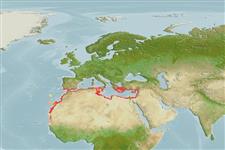Common names from other countries
Пластиножаберные (акулы и скаты) (sharks and rays) >
Myliobatiformes (Stingrays) >
Rhinopteridae (Cownose rays)
Etymology: Rhinoptera: Greek, rhinos = nose + Greek,pteron = fin, wing (Ref. 45335).
Issue
Considered valid in McEachran and Seret 1990 (Ref. 4441) but with a note that more recent authors consider it to be immature stages of R. marginata. Further study is needed to clarify problem (Ref. 4441). Tentatively valid in Last et al., 2016, for these differ subltly in their morphology (Ref. 114953:719).
Environment: milieu / climate zone / depth range / distribution range
экология
морской донно-пелагический. Subtropical; 38°N - 15°N, 18°W - 36°E
Eastern Atlantic: southern Spain to Senegal, including the Mediterranean.
Size / Вес / Возраст
Maturity: Lm ? range ? - ? cm
Max length : 200 cm WD самец/пол неопределен; (Ref. 6678)
Found in tropical to warm temperate coastal waters, but absent from islands of western Pacific. Often forming large groups swimming near the surface and quite destructive of commercial oyster and clam beds. Feeds on bottom-living mollusks, crustaceans and fishes. Seldom marketed. Ovoviviparous, gestation period up to one year with 2-6 embryos produced.
Life cycle and mating behavior
Maturities | размножение | Spawnings | Egg(s) | Fecundities | личинки
Exhibit ovoviparity (aplacental viviparity), with embryos feeding initially on yolk, then receiving additional nourishment from the mother by indirect absorption of uterine fluid enriched with mucus, fat or protein through specialised structures (Ref. 50449).
McEachran, J.D. and B. Séret, 1990. Rhinopteridae. p. 71-72. In J.C. Quero, J.C. Hureau, C. Karrer, A. Post and L. Saldanha (eds.) Check-list of the fishes of the eastern tropical Atlantic (CLOFETA). JNICT, Lisbon; SEI, Paris; and UNESCO, Paris. Vol. 1. (Ref. 4441)
Статус Красного Списка МСОП (Ref. 130435)
CITES (Ref. 128078)
Not Evaluated
Угроза для людей
Harmless
Использование человеком
рыболовство: коммерческий
дополнительная информация
инструменты
Специальные отчеты
Скачать в формате XML
ресурсы в Интернет
Estimates based on models
Preferred temperature (Ref.
115969): 17.1 - 21.7, mean 19.7 (based on 136 cells).
Phylogenetic diversity index (Ref.
82804): PD
50 = 0.5039 [Uniqueness, from 0.5 = low to 2.0 = high].
Bayesian length-weight: a=0.01148 (0.00463 - 0.02844), b=2.98 (2.76 - 3.20), in cm Total Length, based on LWR estimates for this (Sub)family-body shape (Ref.
93245).
Trophic level (Ref.
69278): 3.8 ±0.60 se; based on food items.
устойчивость к внешним воздействиям (Ref.
120179): очень низкий, минимальное время удвоения популяции более 14 лет (Fec=2).
Fishing Vulnerability (Ref.
59153): Very high vulnerability (85 of 100).
